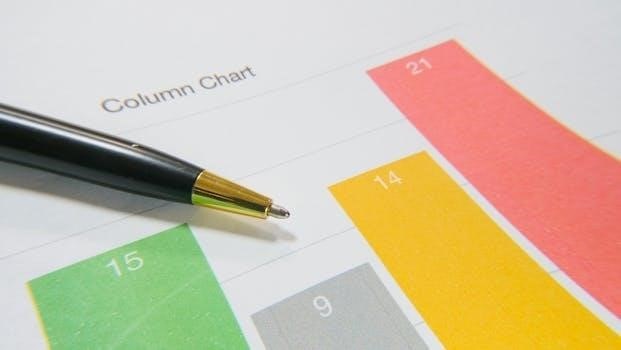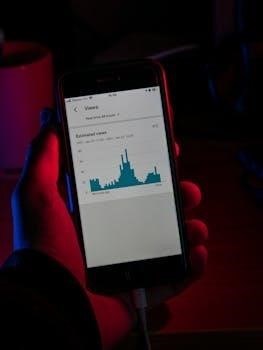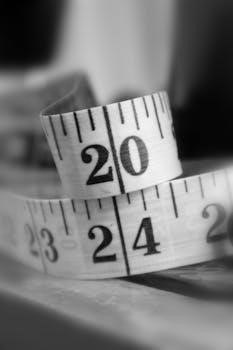Metric Unit Basics
The foundation of the metric system rests upon three fundamental units⁚ the meter for length, the gram for mass or weight, and the liter for liquid volume. These units form the basis for all metric conversions.
Fundamental Units⁚ Meters, Grams, Liters
The meter (m) serves as the base unit for measuring length or distance within the metric system, while the gram (g) is the unit for mass or weight, and the liter (L) is the base unit for measuring volume, especially of liquids. Understanding these three fundamental units is crucial to grasping the simplicity and consistency of the metric system. All other metric units are derived from or are related to these foundational measures through multiples of ten, simplifying conversions and calculations.
Length Conversions
Length conversions within the metric system involve moving between units like millimeters, centimeters, meters, and kilometers. These conversions are based on powers of ten, making calculations straightforward.
Millimeters to Centimeters, Meters to Kilometers
To convert millimeters (mm) to centimeters (cm), divide by 10, as there are 10 mm in 1 cm. Conversely, when converting meters (m) to kilometers (km), divide by 1000, since 1 km equals 1000 m. These conversions involve moving the decimal point, making it easy to scale up to larger units or down to smaller units within the metric length system. Understanding this relationship is essential for accurate length measurements.
Centimeters to Millimeters, Meters to Centimeters
Converting centimeters (cm) to millimeters (mm) is done by multiplying by 10, given that 1 cm contains 10 mm. For converting meters (m) to centimeters (cm), we multiply by 100 since there are 100 cm in 1 m. These conversions move the decimal point to the right, effectively scaling to smaller units. This simple principle is key for precise conversions of length within the metric system, facilitating accurate measurements across scales.
Volume Conversions
Volume conversions within the metric system often involve liters (L), milliliters (ml), and kiloliters (kl). These units are used to measure liquid capacity and are easily converted using multiples of ten.

Milliliters to Liters, Liters to Kiloliters
Converting milliliters (ml) to liters (L) requires dividing by 1000, since there are 1000 milliliters in one liter. Conversely, to convert from liters to kiloliters (kl), you must also divide by 1000, as one kiloliter contains 1000 liters. These conversions are crucial for various applications involving liquid measurements and using the metric system, and the conversion factor is always 1000.

Cubic Centimeters to Milliliters
The conversion between cubic centimeters (cc or cm³) and milliliters (ml) is direct and straightforward⁚ one cubic centimeter is precisely equivalent to one milliliter. This one-to-one relationship makes conversions between these units effortless. Therefore, when you have a measurement in cubic centimeters, you can directly substitute it with the same numerical value in milliliters and vice versa without any calculation needed, meaning they are interchangeable.
Weight Conversions
Weight in the metric system is primarily measured using grams. Conversions within this system involve moving decimal places based on the prefixes. Common conversions are grams to kilograms and milligrams to grams.
Grams to Kilograms
To convert grams to kilograms, you divide the number of grams by 1000. Since a kilogram is larger than a gram, you need to determine how many thousands of grams are in the quantity you have. For example, 1000 grams equals 1 kilogram, and 2500 grams would be equal to 2.5 kilograms. This conversion is vital when working with larger quantities or heavy objects.
Milligrams to Grams
Converting milligrams to grams involves dividing the milligram value by 1000. This is because one gram is equivalent to 1000 milligrams. For example, to convert 500 milligrams to grams, you would divide 500 by 1000, resulting in 0.5 grams. This conversion is frequently used when dealing with small quantities, such as in medicine or chemistry, where precision is important and the mass is small.
Area Conversions
Area conversions within the metric system involve squared units, such as square millimeters, square centimeters, and square meters. These conversions are essential for calculating surface areas and other planar measurements.
Square Millimeters to Square Centimeters
Converting from square millimeters to square centimeters requires dividing by 100, because there are 10 millimeters in one centimeter, and when dealing with area, the conversion factor is squared. This relationship is crucial for precise calculations when dealing with small surfaces. For instance, if you have a measurement in square millimeters and need it in square centimeters, divide by 100. Similarly, 1 square centimeter is equal to 100 square millimeters.
Square Centimeters to Square Meters
To convert square centimeters to square meters, one must divide by 10,000, since there are 100 centimeters in one meter, and this factor is squared for area conversions. This conversion is common when transitioning from smaller area measurements to larger ones. For example, a value in square centimeters, when divided by 10,000, will give you the equivalent area in square meters. Conversely, 1 square meter is equivalent to 10,000 square centimeters.

Temperature Conversions
Temperature conversions require specific formulas because Celsius and Fahrenheit scales differ significantly. These formulas involve multiple operations to ensure accurate conversions between the two systems.
Celsius to Fahrenheit Conversion Formula
To convert a temperature from Celsius to Fahrenheit, you multiply the Celsius temperature by 1.8, which is the same as 9/5, and then add 32 to the result. This formula, F = (C * 1.8) + 32, is essential for accurately changing temperature measurements from the metric system to the imperial system. It’s a critical conversion when comparing temperatures used in different regions or contexts.
Fahrenheit to Celsius Conversion Formula
Converting temperatures from Fahrenheit to Celsius requires a specific formula⁚ first, subtract 32 from the Fahrenheit temperature; then, divide the result by 1.8, which is the same as 9/5. The formula is represented as C = (F ⏤ 32) / 1.8. This calculation allows precise conversion from the imperial to the metric temperature scale, ensuring accurate data interpretation in various scientific and everyday applications.
Metric Prefixes
Metric prefixes denote multiples or fractions of base units. Common prefixes include kilo, hecto, deca, deci, centi, and milli, each representing a power of ten, simplifying large and small measurements.
Kilo, Hecto, Deca, Deci, Centi, Milli
The metric system employs prefixes like kilo, hecto, and deca to denote units larger than the base unit, with kilo representing 1000 times the base unit. Conversely, deci, centi, and milli represent smaller units; deci is one-tenth, centi is one-hundredth, and milli is one-thousandth of the base unit. These prefixes make it easy to convert between different measurement scales and are very useful in science and daily life. They help to show how much larger or smaller a measurement is, compared to the base unit, using powers of ten.
Conversion Chart Formats
Metric conversion charts are available in various formats, including printable PDF templates for easy reference. There are also online interactive charts that allow for dynamic conversions, making them user-friendly.

Printable PDF Templates
Printable PDF templates offer a convenient way to have metric conversion charts readily available. These templates can be easily downloaded and printed, providing a tangible reference for various metric units. They typically include conversions for length, weight, volume, and sometimes temperature. These templates are designed for quick look-ups, and are helpful for situations where digital devices are not available. These templates are also great to use as an easy study aid.
Online Interactive Charts
Online interactive charts provide a dynamic approach to metric conversions. These digital tools often allow users to input values and instantly see the converted results across different units. Interactive charts may also include features like visual aids and step-by-step guides, enhancing the learning process. They are accessible on various devices, making metric conversions easy and convenient for users. This accessibility greatly helps with understanding the different conversions.
Using Conversion Charts
Conversion charts simplify metric conversions by providing a visual reference. They assist in understanding decimal point movement. They can also help with conversions between metric and imperial systems, making measurement easier.
Decimal Point Movement in Metric Conversions
Metric conversions are simplified by understanding decimal point movement. Each change in prefix within the metric system represents a shift of the decimal point. Moving down the metric chart, like from kilograms to grams, involves adding decimal places. Conversely, moving up the chart, such as from millimeters to meters, requires moving the decimal to the left. This consistent pattern makes metric conversions straightforward and easily accomplished using a chart.
Metric to Imperial Conversions
Converting between metric and imperial units requires specific conversion factors as the systems are very different. For example, inches are converted to millimeters by multiplying by 25.4, and feet to meters by multiplying by 0.3048. These conversions are not as straightforward as metric-to-metric conversions and often necessitate using a conversion table or calculator. The metric system uses base 10, whereas the imperial system uses other bases.
